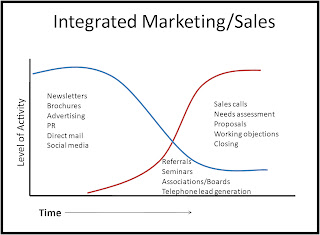Content Marketing: A New Tool in Your Old Toolbox
If you’ve read anything about marketing strategy in the past year or so, you’ve probably noticed the term content marketing making its way into a lot of headlines. Also known as in-bound marketing, content marketing is creating or re-publishing relevant and valuable content online in order to attract and retain clients. Content can be anything from a whitepaper to a video clip to an article or info graphic.
What makes content marketing attractive to most firms is the idea that it can be used to lure the attention of clients and prospects, educate them about how you help solve their issues, capture some information about them and, when they are ready to discuss a solution with you, encourages them to contact your firm. Thus, the term in-bound marketing — meaning prospects that are ready to do business contact you directly. If you’re like many professionals and have an aversion to sales, the idea of prospects calling and asking you to do their work holds a lot of appeal. It sounds like the silver bullet. The holy grail. The coup de grace.
And, because there is so much buzz around the term content marketing, it’s tempting to think that it’s a new invention.
Content marketing is garnering a lot of attention — for good reason. It can be a very effective marketing tool. It certainly needs to be a part of a firm’s marketing mix. But it is only one of many tools that leading firms will implement as the battle for market-share wages on. Firms that place all their emphasis on publishing content may be missing the point. Content marketing isn’t new. There are new platforms — online outlets, more sophisticated email marketing systems, and automation tools to make getting content out to your target market and collecting lead information easier and timelier.
But all marketing — regardless of the distribution channel — is content marketing. The most successful firms have been content marketing all along.
Presenting a seminar or webinar to an interested audience relies on valuable and relevant content to position you as an expert. Mailing a newsletter via (gasp!) snail mail relies on content. Asking questions during a sales call and discussing solutions and benefits in a way that is meaningful to the person you’re addressing is essentially delivering content. EVERYTHING in marketing should have a value-add basis. If it doesn’t, you’re wasting your time and resources.
Also, prospects have different preferences when it comes to communication. As old-fashioned as it may sound, some prospects still prefer to receive communications in a printed format and not all your prospects are utilizing electronic media to the same extent. A mix of channels is your best bet in reaching the most prospects.
While it may sound like content/in-bound marketing will have people knocking down your door to do business; most in-bound leads will still require proactive follow up and working the sales cycle. Improving the quality of your opportunities is also dependent on your ability to market your content to the right audience. The fundamentals of defining a target audience, understanding the issues relevant to that audience, communicating with that audience, tying your solutions to their needs and articulating the benefits of working with you to solve the issue may sound like and old-school approach. Don’t abandon the fundamentals in favor of a — approach. It’s only through applying these proven fundamentals from your marketing tool box that your new tools yield results.
Instead, figure out how to incorporate new tools into your marketing mix. How can you use social media to promote your events? How can you turn a conversation with a client about a challenge they are experiencing into an article you can post on LinkedIn or a blog? Then, make sure you have a plan in place to promote your content to your target market. This integrated approach will yield not only leads, but quality opportunities for your firm.

